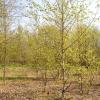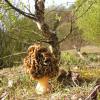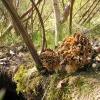
26-12-2025 21:19
Arnold BüschlenPithyella challaudii Pirou. Ist als Bryoparasit in

18-12-2025 21:17
Pol DebaenstThe identification took me to Byssonectria deformi

21-12-2025 09:32
Hello.A tiny ascomycete found embedded in wood in

24-12-2025 17:08
Hulda Caroline HolteHello, I have found this propoloid ascomycete on

21-12-2025 21:32
Pol DebaenstHello, Garden, Burgweg 19, Veurne, BelgiumOn 10/1

Bonjour,
Nous avons une Morchella dans une sablière. Comme arbres, ill n´y a que des Salix et Betula.
Est-ce que vous connaissez des Morchellas dans ces biotopes?

Hello Tanja,
I am not a specialist in Morchella - so please take my answer with caution.
Anyway, I think that your collection should be Morchella vulgaris - this is the form that is dealt with as M. spongiola in the paper of Kellner & al., as one of three species of the Morchella esculenta-complex growing in Central Europe. M. vulgaris is darker and longer staying dark compared with exculenta (crassipes) and americana (esculenta) - and the species with the least tree specifity (esculenta mainly growing with Fraxinus and americana with Populus). Thanks to Pierre-Arthur Moreau who gave me some information.
I am looking forward to other opinions.
Best regards from Lothar


